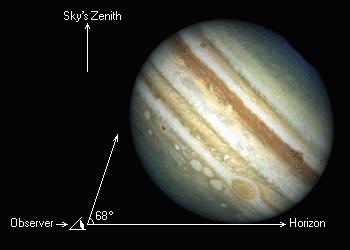
(Or: how much one can get out of drawing circles)
Imagine you were at Metis, Jupiter’s closest moon, which rotates at a distance of 127,960 km (79,513 miles) from the center of the planet. The following drawing attempts to give you an idea of what Jupiter would look like after rising over the horizon (actually, how much of the sky would be covered by Jupiter’s disk).

How about those 68 degrees of a disk, side to side, hovering over your head? (In reality, with a diameter of only 40 km, Metis doesn’t produce much gravity to let you feel you step firmly on the ground, with Jupiter over your head. Rather, you would feel like flying in space, barely attracted to the satellite’s surface.)
Want to see how your view of the planet would change if you were to set your foot on Jupiter’s largest moon, Ganymede? At a distance of around 1,070,000 km (665,000 miles), here is what you would "see":

In this figure, the angle of Jupiter’s disk on Ganymede’s sky is shown, equal to 7.65 degrees, while I kept the observer’s horizontal distance the same as in the figure above for Metis, to be able to compare the relative sizes of Jupiter’s disks. Even though Jupiter looks tiny in this figure, 7.65 degrees on the sky would still be quite impressive. For comparison, notice that the Sun’s disk as viewed from Earth is only 32 minutes of a degree (about half a degree) across, which makes it fourteen times smaller. This means that if Jupiter’s disk as viewed from Ganymede were to be superimposed on Sun’s disk as viewed from Earth, it would be fourteen times larger! Try to imagine this because it is not easy to draw.
Ganymede with a diameter of 5,262 km (3,270 miles), is the largest moon in the solar system, larger than the planets Mercury and Pluto, and barely smaller than Mars. My guess is that if and when we visit the Jovian system (Jupiter & its satellites), the first place we would prefer to set our foot on would be Ganymede (I mean it: our foot, not our machinery), with Callisto as a close second candidate.